Warning: This post contains graphic photos of the butchering process. Do not read any further unless you are genuinely interested in learning how to butcher animals.
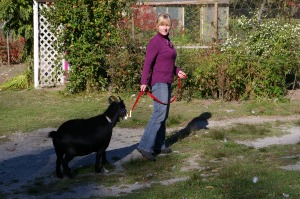
Leading Sundown to her meeting with her maker.
Well, I had thought I would have to wait until hunting season was over in order to muster the courage to do in one of my goats; but after butchering the rest of my ‘Jenny Craig’ Cornish Crosses (25) and all of my turkeys (32) this week, I found I was in the mood to keep going. My friend Clarence called last night to see if I wanted to go for breakfast this morning, “A pick up and delivery,” he said, letting me know he would do the driving. He took me for pancakes at the local diner, and over breakfast we talked about various things, the upcoming moose hunt being one. “You know, I saw a big bull moose on Wednesday on my way home from Williams Lake. He crossed the road in front of me right there at Louis Creek,” hands moving out in front of himself from left to right, “and he had your initials on his ear, my dear.”
While on the subject of meat, I asked him if he’d help me butcher one of my goats,”Why sure. Any time. When do you want to do it?” “Today, after breakfast.” He said he had a few things to attend to first but that he’d be back later in the afternoon. When he dropped me off he called out, “I’ll be back at 2pm to help you out, OK!”
When I asked him if he would mind helping, I imagined that he would do the actual killing part; after all, that was the part that I thought I would have the trouble with. However, when he arrived there was no discussion about whether or not I’d be doing the shooting. “OK my dear, place the bullet right here,” he gestured with his left finger-tip-less hand to her forehead. “You only need one cartridge to do it right and she’ll go down, just-like-that.”
I was surprised by my own matter-of-factness. After all, I’d named and tended to Sundown for nearly five years. But my only concern was that I shoot her well so she wouldn’t suffer–I certainly didn’t want to have to shoot her twice or, god forbid, a few times. She was pretty calm as I led her to the ‘gallows tree’ but every now and then kicked against the rope that held her. I was a bit concerned that she would kick up a fuss just as I was about to shoot so I got in close, took aim quickly and fired. She went down instantly, “That’s it. It’s all over.” Before I really registered that I’d done it, Clarence was already slitting her throat and she was bleeding out.
We went to work on skinning her front side before hanging her from the tree so we could spill the entrails. He talked me through most of the work–I like that about Clarence: he doesn’t take over and do the job for you. Rather, as a good teacher and mentor he’s happy to watch over his apprentice and even endure a few mistakes. “Oh my, she is fat… I don’t think I’ve ever seen so much fat on an animal I’ve butchered before!” he said, cutting through the beautiful white lard that was between her body and her skin. Indeed she was fat–too fat. I’d been feeding the nursing goats a lot more in order to keep their weight on, and the other goats were clearly taking advantage of the extra grains, hay and forage.
Once we had the goat butchered out, I sawed her in half and split her into two sides until she looked like two minuscule sides of beef. Clarence helped me rinse her off and bag her up, before he left. I then put her in the truck and drove her to the local butcher for hanging. On the way in to the store, I barely got a second look. On the way out, however, I stopped to talk to a friend then as I went to leave a stranger nodded politely at me. “After you,” he said gently motioning to the doorway, looking me up and down, “A bag of blood in your hand, and blood spatter on your pants… I’d hate to think what happened to the guy that cut you off!”
Step one: shoot the goat in the forehead. If you do not know how to do this, or do not have a good understanding of the animal’s anatomy, then get someone experienced to help you. This should be a clean kill so the animal does not suffer needlessly. Although this was my first time, I had Clarence watching over me as I did this. Also, I now have a lot of animal butchering experience and know exactly where to place the bullet.
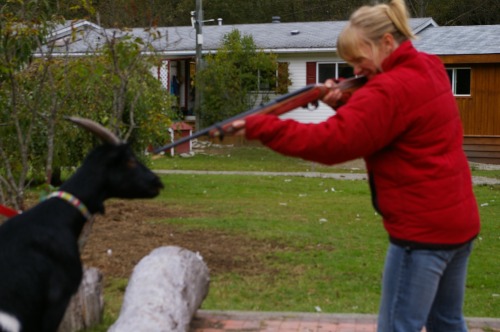
Get close to the goat with the gun so you don't miss in the event she moves.
Step two: slit throat being sure to cut through both jugular veins so it bleeds well and completely.
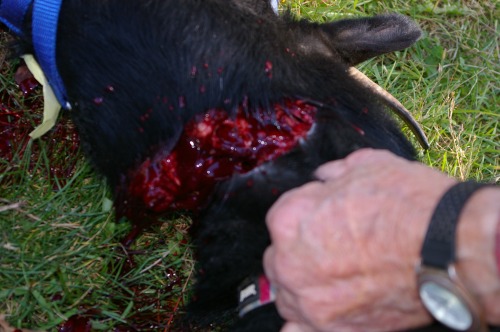
Be sure to slice through both jugular veins on either side of the windpipe to get a good bleed.
Step three: slit skin from ankle to anus on either back leg and then slit the skin up the belly to the neck. Begin to skin the goat separating the skin from the meat.
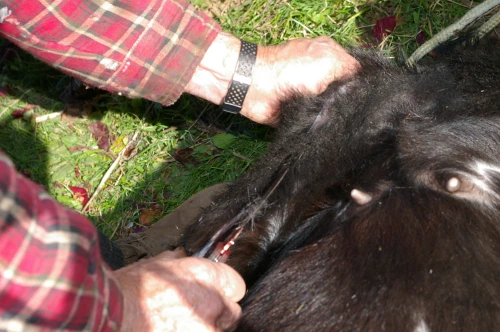
Make a cut through the skin from the ankle to the anus on both hind legs.
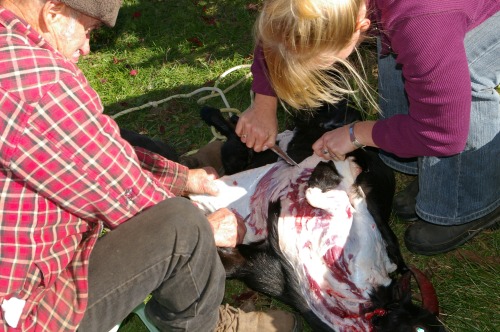
Carefully separate the skin from the animal leaving the meat with the carcass.
Step four: When the skin is off the front of the body, make two cuts in the ankle between the tendon and the bone with your knife. These holes are for slipping a rope through in order to hang the goat. Hang the goat high enough to continue working comfortably.
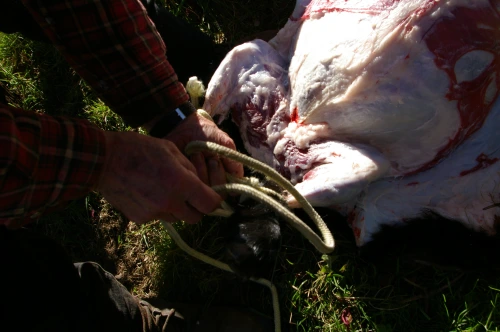
Cut hole between the tendon and bone of each hind leg then slip a rope through for hanging.
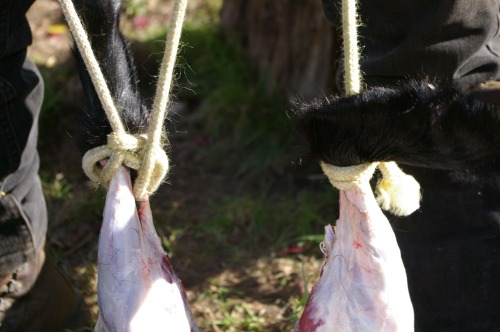
Rope threaded through legs for hanging.
Step five: Finish skinning the goat completely and cut the head off the goat.
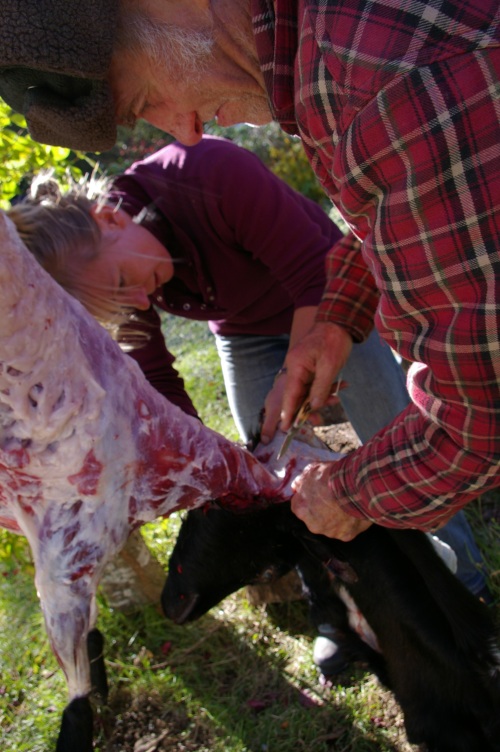
Once the skin is completely off the animal, you can sever the head away from the carcass.
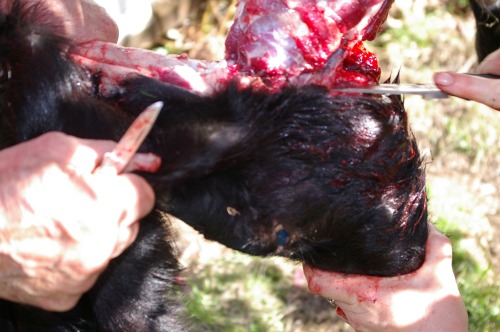
With a knife or meat saw, remove the head once you get the animal completely skinned.
Step six: Cut the belly open carefully making sure not to cut the intestines. You want to just cut through the skin. When you get to the breast bone you will need a meat saw to finish cutting to the neck.
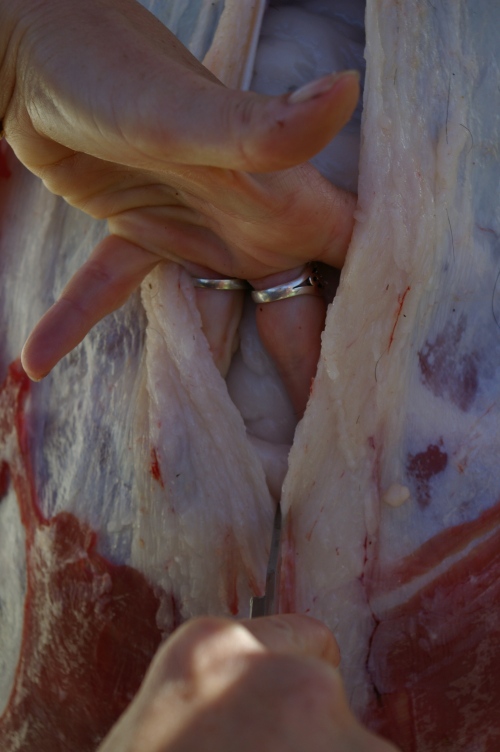
Carefully cut open the belly of the goat being diligent about not cutting any of the innards.
Step six: Begin to let some of the contents fall out of your way. Take the meat saw and cut through the pelvis. Grab a hold of the rectum with one hand and cut the anus away from the inside of the goat. Do not cut the intestine or rectum! Let the contents spill out of the cavity.
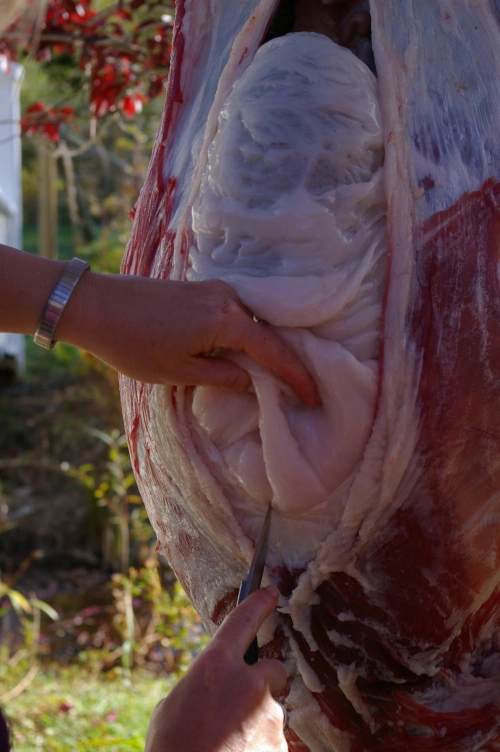
Open the belly up completely being careful not to let the innards begin to fall as the rectum will rip and spill fecal contents throughout the belly cavity.
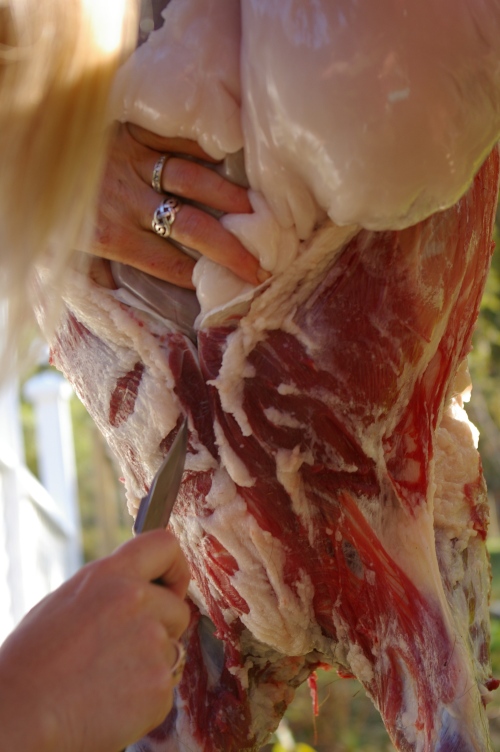
With a meat saw (or in my case my knife) cut through the breast bone right up to the neck.
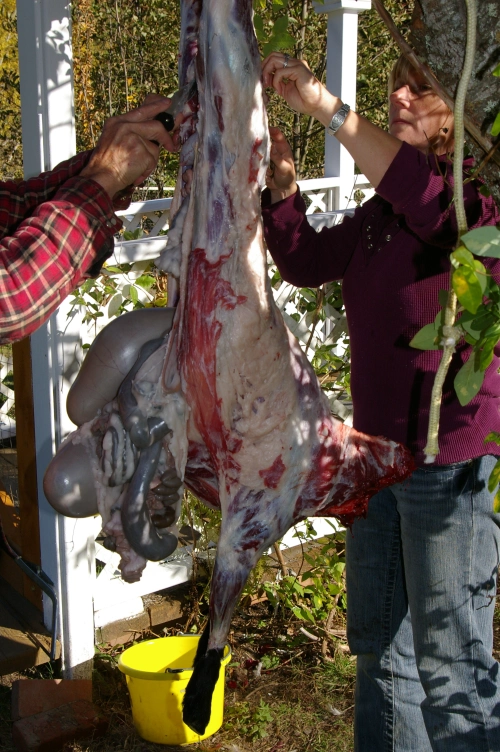
Cut through the pubic bone and around the anus so it can come free as you pull out the rectum along with the innards.
Step seven: Save the heart and liver. Cut the heart open and bleed it. Wash the liver and heart well and put in cold water until you can refrigerate them.
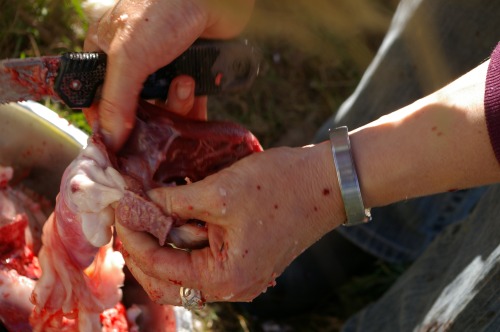
Cut open the heart and rinse the blood out of it.
Step eight: Cut the esophagus and trachea away from the neck and throat area.
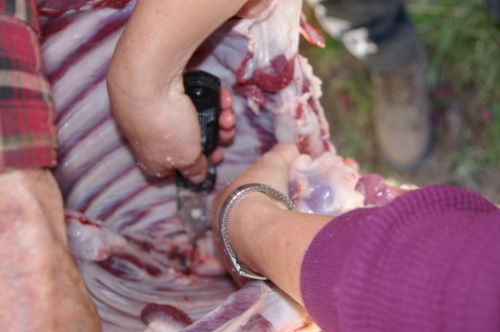
Esophagus and trachea removal.
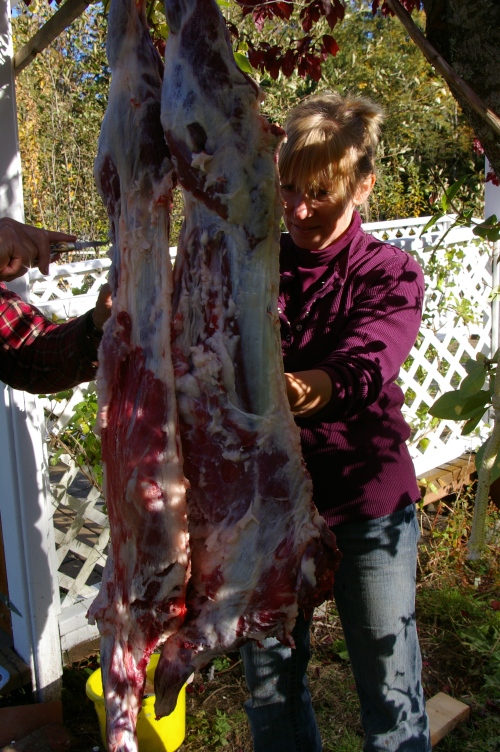
Goat carcass cut into two sides. We are not cutting off the extra fat before taking the meat to the butcher for hanging.
Step nine: With the meat saw, cut the carcass in half from tail to tip. You now have two sides of goat ready for hanging in a meat cooler. Wash them with clean water and hang for several days to cure.
As for how I’ll cook it? I’ll likely follow one of these tasty suggestions from Phelan of a Homesteading Neophyte!


Boy, I wish I had had this to read in the days when we had goats up in Firvale!
Looking forward to seeing how you cook it up.
SBW
I’m looking forward to that too… I’m planning to have a few folks over who are interested in trying goat meat for a big feast. Wish you were here to help enjoy it!
cheers,
HDR
Pingback: The Butchering Process | All Things Goat
Interesting. Different than how we field dress an animal – de-entrailing them first, then skinning them. Other than that – the end result is the same.
The photo of you with the gun is fantastic. Not in my frame of reference from hunting. And something I always wondered about: what it’d be like to harvest an animal you raised. Good for you.
I have little experience with goat cookery, but I’m guessing that if butchered/cut like any other larger animal, you’d have a variety of cuts to do various things with. I’d be interested in the tenderloins for a carpaccio – the loins [backstraps] might work well too as they shouldn’t be too large. Front legs mostly for ground – worth trying braised shanks to see how it is. Not sure how the connective tissue would break down in a goat – shoulder roasts are one of my favorites with beef/pork but with game meats it just doesn’t break down and fall apart. Plus, the connective tissue simply tastes bad and is gross with moose, deer, elk. No idea with goat – let me know if you know or learn by doing how it reacts. The rump/round is where I’d be cutting steaks for various uses. Roasts if you’re into roasts. The trim I’d try curries, sausage, stews, ground etc. Sounds like a tasty adventure!!
I think the fact that Clarence skins first and guts second comes from the taxidermy professional in him. The first question before any cut was made was, “Are you going to keep the skin?” I said yes because I want to know how to do it and preserve the hide even though I didn’t save this goat hide. I will be saving some of the others’ hides in the future.
Will keep you posted as to what I end up doing with the goat! Thanks for the suggestions.
cheers,
HDR
Shoulder roasts are my favorite from the white tail deer I harvest every year. That meat cooked with potatos, carrots, and onions very slowly. Meat falls off the bone and becomes very “soft”. Grat with brown gravy. I sure a goat shoulder would be just as good.
You are brave! Thanks for a great informative post. And happy birthday!
Beautifully done! You saved me the need to document when we butcher next. Your post covered all the salient points.
I’m looking for an easy tanning recipe so when you decide to do some hides, let me know how it goes.
The easiest way to tan the hide is to use the brains. Every animal has enough brains to tan their own hides! I will do a post on that when I do keep the hide.
cheers,
HDR
I looked but I didn’t find a post on tanning the hides. Did you do one, or did I just miss it?
Thanks
Linda
Hello,
Wondering the same as lindercroft. Did you get around to writing a tanning post? Our buckling harvest is in two days and he has such a fine pelt that I’d like to save it. I’ll look again.
Good for you! And thanks for posting it! I have done birds so far, but that is it. I’m a bit nervous about doing goat, or pig. I’ll definitely be referring back next year…once we have kids.
And happy birthday! 🙂
Clarence & his pancakes, legend.
Excellent post. Even if graphic, I think people deserve to know how their food looks like before it comes in the plastic container with the big “M” on it. I once joined in on a goatbutchering in Mongolia, which was completely different. Two persons (in this case two teenage girls) would hold the goat on her back while one of them cut a small opening in her chest right under the chest bone. Then the girl would reach inside the living goat and with her fingers clamp the main body artery, knocking the goat out cold in less than five seconds. Then she would cut the artery with a small but sharp knife and give it a few seconds to bleed before opening up the front and using a plastic cup to scoop out the blood that was poured in a bucket to save for later. When the majority of blood was scooped out the proceeded to open the goat, leaving the skin attached to legs and head and stretched out like an upside down “tent”, or bowl. They would then butcher the body whilst still in the “tent” of the skin and carve as much meat as they could from the bones while preserving all the internal organs. The rectum was thrown to the dogs but the intestines were washed out with some clean water and while one girl was finishing of the butchering one girl would pour the blood into the entrails and tying little knots to make nicely sized blood sausages. Finally the hooves would be cut of, and the bones and head (now skinned) would be thrown into a pot of boiling water. The skin would be saved for later.
Not one drop of blood was spilt and only the hooves remained after the dogs had eaten the rectum. The contents of the stomach and entrails (i.e. poop) was washed out on the ground to fertilize semi-dessert valley floor.
The goat would last a family of 10 a few days and the last of the boiled out bones would be given to the dogs to toy with. The hooves disappeared over night (probably some vulture took them).
Excellent use of a whole goat and a very nimble way of butchering! I still have those color negatives I took somewhere in the old country. Have to dig them up when I get the chance!
Great post. I too, raise goats, and understand the need to cull the herd. Only problem is that nobody in my area seems to hold the skills to show me how to do it.
It’s an extremely important skill–knowing how to skin and cook meat. Yet, so few people today know how to do it.
The post is saved…and if I can garner the courage and get someone to show me how someday, will follow your steps.
David
David,
Where do you live? And, did you ever find a tutor?
cheers,
HDR
Goats have extra thick skulls in the front. They should be shot in the back of the head. If your goat had been a buck, it most likely wouldn’t have died from your first shot. This happened to a goat I was going to butcher. It was very unpleasant. You got lucky because you butchered a doe. Thanks for the post.
Hi Wendy,
Actually, only the first goat was a doe. The rest of the goats I’ve butchered have been bucks, all shot between the eyes, and all dropped on the first shot immediately. I’ve not ever seen/heard or read about having to shoot a buck in the back of the head. Thanks for sharing.
Kristeva
I have to agree with Wendy, you have gotten lucky. I live by two different goat farms where they butcher alot of goats, and I myself have been butchering goats a long time. You dont shoot them between the eyes, but the back of the head. Believe me you wont always be so lucky.
http://www.ozarkjewels.net/homebutchering.htm
I found this to be a great site to go to, but there are many others that will tell you to also shoot in the back of the head.
Great post. My only question is what caliber rifle or pistol you used?
Hi Bill,
It is a Rutger semi-automatic .22. rifle. Quite sufficient for the task at hand.
cheers,
Kristeva
Not sure if it was covered (sorry if it was).
But what do you do with the awful?
I either bury it in the yard and compost it, or take it to the dump where the eagles and ravens scavenge it up in minutes.
l have had goats for the past 34 years. l have been butchering for the past 44 years professionaly. Goats are killed in the back of the head where the hair whirl exists. Use .22 short hollow bullets to instantly kill them. If the head is to be used for food use use solid long point .22 bullets, and there won’t be lead in the head [depends on maturity of the goat, kids use short solid .22]
The newer designed bullets are using steel now.
May I ask why the neck is slit. Can u butcher without slitting the neck
You have to bleed the animal. This is why when I butcher poultry, I silt their jugular veins as well but leave the birds alive. I still string them up but their hearts work to help pump the blood out of the birds. However, when an animal is shot as is the case with the goats, the heart stops pumping. Therefore, the only way to bleed it is to let gravity to the work for you. So we slit the throat and hang it up by its back legs and let the blood drain.
cheers,
Kristeva
thanks for info…it looks like your shooting between eyes yes? i saw another person do it from behind…concerned cause yes my goat has a name..will never name another.lol.
Hello Paris,
Yes, I shoot them between the eyes. Others do it as you say, from behind, however I was taught to do it that way. I’ve named all my goats and yes, this can make it more difficult to ‘do the deed’ when the time comes. However, I have found it is not so much the naming that does it but more their individual personalities that make it more difficult! It’s a fact, some goats you just have a better relationship with and like more. Not unlike people!
Good luck with it.
Kristeva
We have had Goats for about 7yrs now
I butcher my own goats, Learnt myself how
I pretty much do the butchering, the way you do it
and yes goats have personality’s
some you can not wait for them to get old enough to dispatch,
1 I have he is 5 yrs old can’t do the deed
We like the Goat meat
have cured some hind quarters & smoked like hams
very nice, if you get them fat enough you can do the ribs as Bacon
Barry from Australia
Loved your photos. Have been raising goats for years. Was nice to see some like-minded people who dont look down upon people who enjoy goat meat. Some advice: Never name the meat! LOL!
Awesome description. We are new to dairy goats and well they have to kid so we can have milk. So we are thinking of butchering some of the young when they come to age. We have butcherd small animals before but these will be big for us, so it is nice to see how its done. My question is, would it be harder to kill a buck with a bullet straight on? would you want to go from the side? Since it seems like the bucks have harder heads with the horns and all. Like you, we want no suffering, just one shot. Thank you
Hello Travis,
I would say no. That one shot to the head in the centre between the eyes will be fine. I have heard people say that the bucks have harder heads, etc. But in my experience the bucks and the does go down in one shot. For one thing, you shoot them at point blank range! I would worry that if you shot at the side, that you might miss the brain, or part of it. Having said all that, I don’t consider myself an expert but I did consult experts before attempting this.
Good luck! feel free to check back in and let me know how it went. I always enjoy hearing about other’s experiences!
Kristeva
Thank you! Very clear and well put together, I don’t have a saw to cut it in half but I’m glad I saw the last note about curing the meat for a couple of days 🙂
Love from NZ
Hey Juancho!
Where in NZ are you? I spent 6 years living there. In fact, I graduated Uni from Massey and then Masters degree from Waikato… Loved it!
Kristeva
This is very different from how I do it. But a good informative post.
My method is adapted from how I was taught to butcher a deer, without cutting through any bones at all, which leaves me with boneless steaks, roasts and stew meat.
A lot of people also believe you get milder flavored meat if you avoid “bone in” processing.
Why would you shoot the goat first? That is just silly. You can slit the throat with minimal effort.
Rguyah,
I shoot first because that is the way I was taught. I’ve only seen the throat slitting in videos so I would hesitate to do it that way until I was shown first hand. But yes, it is certainly an efficient way and that is how I kill chickens, ducks, turkeys.
cheers,
HDR
Pingback: Skin goat | Trelittle
Skinned the African way, that’s how we skin from tradition. We don’t use guns though but cut straight the veins in the neck to bleed while heart is pumping for better bleeding. What happens to the potentially poisonous meat around the bullet in the head..what with gun powder. You forgot to warn users from danger of slicing open the gall bladder which will completely sour the meat. Its located near the rectum, its cream/whitish normally fully inflated organ, the size of a kidney. You puncture that I’m sorry. To save as much meat from skin during skinning, use your fist to tear skin away from meat once you’ve cleared enough skin to hold, you will get clean UN-lacerated meat. When ready to slice open the belly, have a large dish or wheel barrow ready to receive the heavy intestines & stomach. You can’t hold them as they are slippery & slimy. Otherwise many thanks…!
Hello,
We are embarking on our first foray into self-sufficiency, we have 75 acres & were hoping to do our butchering, our two girls Lillii 3 & Ffion 2 years already help us pluck the chickens, I want to show them where their food “REALLY” comes from. Your post on butchering goats will be a great help to us in the future, we only have 4 goats but we want to breed more in the future, we have named our goats because even though we know they are our future sustinance we like to enjoy their personalities while we can…its the circle of life isnt it…I admire your “gumption” in doing all of the dirty work yourself…I will definatly be getting my hands dirty in the future while providing my family with good home grown meat. My mum’s Italian friends make the best goat curry ever!!
Great post…I’ll keep on reading for more ideas!!
Thanks…The Williams Clan.
Hello Xandra,
Thank you for taking the time to write. When you to butcher your own goats I encourage you to try my Slow Roasted Goat Leg recipe. Lost of people put goat into curries because they think they need to ‘disguise’ the flavour of the meat. You will find, I’m sure, that this is unnecessary and will enjoy learning how to cook it in a variety of ways that actually highlight the meat.
Good luck!
Kristeva
Hello Kristeva,
I am typing this as one very proud butcher of goats! We did 3 of our smaller goats today! My Husband & I printed out your instructions and took them with us as a handy guide, they were a HUGE help!
My husband did all of the actual butchering as I am six months pregnant and he decided that he didn’t want me “cutting my finger off!”, I did get my hands a bit dirty, i held the cavity open as the innards fell away, so i guess I was his apprentice! It was very sweet of him to want me to be safe though! As I am quite a good shot I did shoot one of the goats myself and after naming & tending to them for 6 months I thought Id be a but squemish, but it was surprisingly easy.
My two daughters Ffion 2 & Lillii 3 were very interested and would not be left out, I was initially worried that they would be upset (they kind of just ran out to where we were skinning and got an eye full!) but since we will be increasingly self-sufficient in the future I thought it would be better to tell them how it is in real life so I just said we are going to eat this goat now, and dad is skinning him, so we can cook the meat for tea, is that ok? They were both delighted (im not sure if I should be shocked or proud? haha!) But part of our aim for the future is to teach our children where our food comes from, and you have help us get on the right track, so a big thank you!
I will definatly try your suggested recipie as we have 12 goat legs to get through!! haha!
So thanks you once again, for such an informative blog!
The Williams Clan.
Great post!
We are about to embark on the process ourselves for the first time (to get out of paying the abattoir). Have you thought about doing a post on how to break the carcass down into particular cuts?
Thanks
James
Pingback: Goat graphic | Winnersatgamin
does anyone know how much you charge someone that wants to buy a goat for meat?? and then wants you to butcher it??? is it by the head or by the pound live weight or by the pound hanging weight??
Hello Paulette,
I always charged by the pound by dressed weight. In other words, do the butchering and weigh the carcass empty of it’s visceral contents.
good luck,
Kristeva
Pingback: How to butcher goats? - Page 2 - Patrol 4x4 - Nissan Patrol Forum
For fun I have been surfing butchering sites since I have just learned the web. I find many are somewhat informative and tho the methods would work they are not like we did it as I was growing up. I guess no matter the method the important thing I see is hygiene. Keep meat clean and keep hair off the meat.( especially with male animals) With wild game keep all gland secretions off the meat. And be certain the animal is rested and not been stressed before slaughter. Rapid cooling is very important and proper care of meat after butchering is all very important to Aviod spoilage and retain ( inhanse ) flavor.
A friend of mine shoots beef cattle above and behind the right eye. He says it leaves the animals heart beating for a short time to help bleed out after the throat is cut. Wondering if it would work on goats, thanks for sharing your experience.
Hi Nick,
The reason we shoot goats between the eyes is that their brains are not as large as a cow’s. Therefore, you have a greater chance of missing the essential bits if you do it the way you would a cow. Some others may feel confident doing it that way, but I’m not. I want to know where my shot is going and have that animal drop in its tracks.
thanks for sharing,
Kristeva
Kinda of a sick bitch aren’t you
Hi Sick Bitch,
As it happens, I do have the flu right now.
Who kills the meat you eat for dinner or clothe yourself with?
Kristeva
Loved that response. Loved this post as well, including the input from others. I enjoyed some of the other posts you’ve put out also.
I will be doing the same to our goat soon. This will be the first time for me as well. I am an experienced hunter but have never killed a goat. Funny, huh?
Well, thanks for the info.
There you go…Good response. Nice to see a woman willing to do what is needed. Nothing sick about it. Man and woman have to eat what God gave us.))
Mark
Thank-you Mark,
That is a nice supportive response… unlike several others I’ve had tonight!
cheers,
Kristeva
If TSHTF you are the type of person that will survive.
I’ve never killed an animal but realize the meat I eat came from someone brave enough to do the actual slaughtering for me.
Sounds silly, but before each meal I thank God for and bless the animal that gave up his/her life for my nourishment.
Thank you for showing us how it’s done.
If I ever have to do this, your blog has helped.
You folks are true freemen and it sounds like you treat your animals nicely while they are alive. They have it better than factory farmed animals who never feel the sunshine on their face or grass and earth on their hooves.
You are a brave woman.
Hi Midwestergrandma,
It’s not easy or fun to do, I’ll tell you that. But, if you want good clean food it becomes necessary. Thanks for the support!
kind regards,
Kristeva
Miss Kristeva,
Well done, and well answered to “Disgusted”. Bravo!
I too kill my own meat, normally white tailed deer. It shares the low fat, low cholesterol nature of goat, and is very healthy. I have learned to skin from the head down, and remove the hide by mechanical means (I use my tractor) otherwise not so different.
Hi Richard,
Yes, I’ve heard of that technique you speak of. I’d like to see it in action one day! I was taught by Clarence how to do it and his son being a taxidermist, are always careful about saving the hide. I think that is the primary reason we do it this way. Also, they are very ‘low’ tech in everything they do. Another reason for the hands on/hands only technique. lol.
Thanks for the vote of confidence. I don’t usually meet my readers/commenters on “their own level”. But her response seemed to warrant it.
Where do you farm??
cheers,
Kristeva
West Tennessee. I manage my property for deer and turkey, and take the grand kids hunting there. Chestnut and pecan grove, along with apples and crab apples, a few pear trees for our consumption and to feed the deer.
Sounds wonderful!
Tradition on our farm in the hills of Tennessee , hang goats by hind legs then slit throat and let them bleed out for maximum blood removal. Eighth generation on this farm. Old Hillbilly
Hi Old Hillbilly,
Yes, well you and Clarence would have a lot to talk about I’m sure! He too is an old hillbilly. And I use that term with the greatest reverence!
cheers,
Kristeva
You should NEVER shoot a goat in the forehead! These animals are made to headbutt each other! This can result in just an injury, and a rush of adrenaline, and worst of all, an inhumane kill!
They need to be shot in the BACK of the head, behind the horns, and if the goat is a large breed, or an old goat, something stronger than a .22 is better.
I read where you are never supposed to shoot in forehead plate of this type of animal, that the back of the head is quicker and will forgoe having to shoot the animal multiple times. Fast and painless is always best. May want to research this….
You are awesome, all around. I live up in VT and love to grow, raise and eat my own food. Looking forward to raising goats in the near future. Thanks for the tips on turning them into tasty morsels.
Great article, I’m planning on slaughtering one of my four buck kids sometime in the near future. It will also be the first time I taste goat, so I’m looking forward to the day.
I’m going to bookmark the page for reference, come ‘the day’.
Loved the article, I’ve killed and butchered a few of my goats over the last few years, but today am deciding what to do with Lenny, who’s been with me from the start, but, just recently become a problem with h is wandering and taking the others with him…..could be meat for dinner 🙂
Pingback: From The Coop to The Table: How To Process a Chicken at Home | Modern Pioneer Magazine
Reblogged this on Modern Pioneer Magazine and commented:
Fall is coming and many will be processing meat soon. Thanks to Howling Duck Ranch for this wonderful tutorial with (graphic) pictures for processing goats.
#goatlifesmatter
Whats the best way of skinning the head? Any tips?
Thanks
Hello Imran,
I have never done it. I suggest looking up on a taxidermy site. Sorry I can’t be more help.
Good luck!
Kristeva
Hello,
I have a question that perhaps you could answer. this is a really helpful step by step but no one is about round where I live to give me instructions so learning is helping. I have listened to my grandfather who slaughtered his animals (large) using a .22 I believe. However, people say that it is incorrect and I can get hurt. Could I ask what type of rifle you are using since you have butchered a goat? I would like to hear from experienced people over a random forum and also does this apply to sheep also?
Thank you.
Hello Meghan,
In the goat butchering picture that is exactly what I am using. A Ruger .22 semiautomatic. Works like a charm. Your grandfather knew what he was doing!
Good Luck, and I’d love to hear how you make out.
Kristeva
How do you retrieve the brains?
I would love to freeze dry them for my pups
You have to open the skull with an axe.
Great work, thanks for sharing!
When you are saving the liver, how do you handle the gall bladder attached to it ?
Hello Paul,
Sorry for the late reply and I hope you found the answer elsewhere. But the answer is carefully! And cut it from
The liver at the point of attachment and separate it as best you can avoiding spilling its contents. Wash any off asap if you do. Good luck!